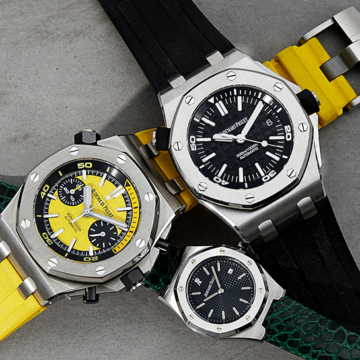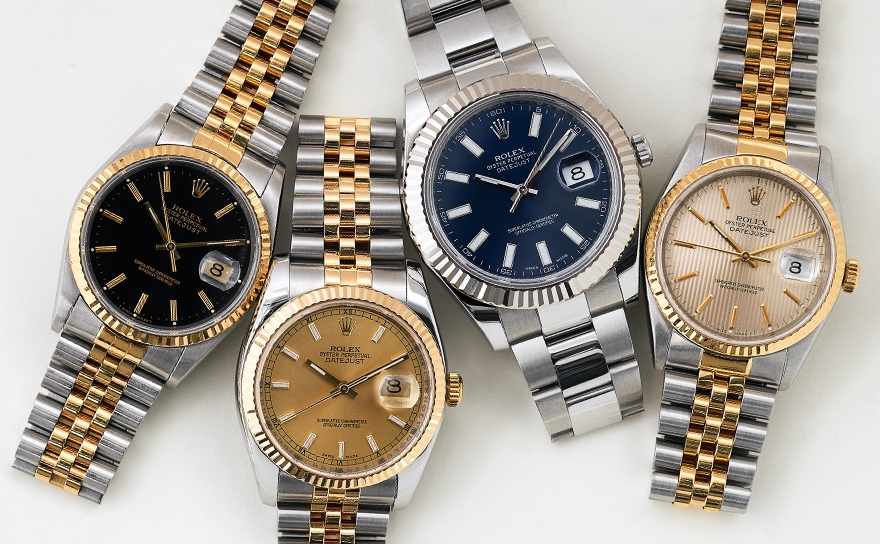
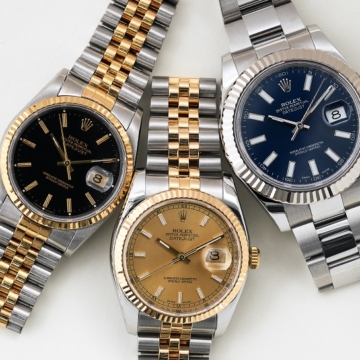
How To Spot A Real Rolex Datejust Watch
For many, Rolex is king in the realm of Swiss watchmaking. The Geneva-based powerhouse has painstakingly produced top-notch timepieces for over a hundred years, and hosts an impressive roster of models. Though Submariners and Cosmograph Daytonas typically steal the spotlight, the classic Datejust actually preceded them. The Rolex Datejust was released in 1945 to commemorate the brand’s 40th anniversary, and judging by its now-legendary status, the model was something of a gift to watch lovers everywhere.
“In the mid-1940s, Rolex combined two watch components that they had designed and mastered over the previous decades — the Oyster case and the Perpetual movement,” explains Hilary Hoge, Fine Jewelry & Watch Valuation Manager at The RealReal. “The Oyster case debuted in 1926 as Rolex’s first waterproof case, and Rolex’s self-winding Perpetual mechanical movement is made with exceptional precision, keeping time on average within two seconds, give or take, per day.” Rolex added a date wheel to these iconic elements, and voilà — the Rolex Datejust was born, establishing a few milestones in the process.
The Datejust was the first self-winding chronometer wristwatch to feature a date complication in a window. It was also the first Rolex model to include the Cyclops lens, which was added to the design in 1953. Other than the inclusion of the magnifying Cyclops lens, however, the Datejust hasn’t changed much since its initial release. “Over the last 75 years, the design has remained virtually the same with the exception of mechanical updates and case size additions,” notes Hoge. “The model has become instantly recognizable, and the Datejust is practically synonymous with the brand Rolex.” With an unmistakable look and unparalleled craftsmanship, it was inevitable that counterfeit versions of the Datejust would emerge. So how can you spot the real deal? Hoge lays out her expert tips for authenticating a Rolex Datejust.
Real Rolex Datejust: The Dial
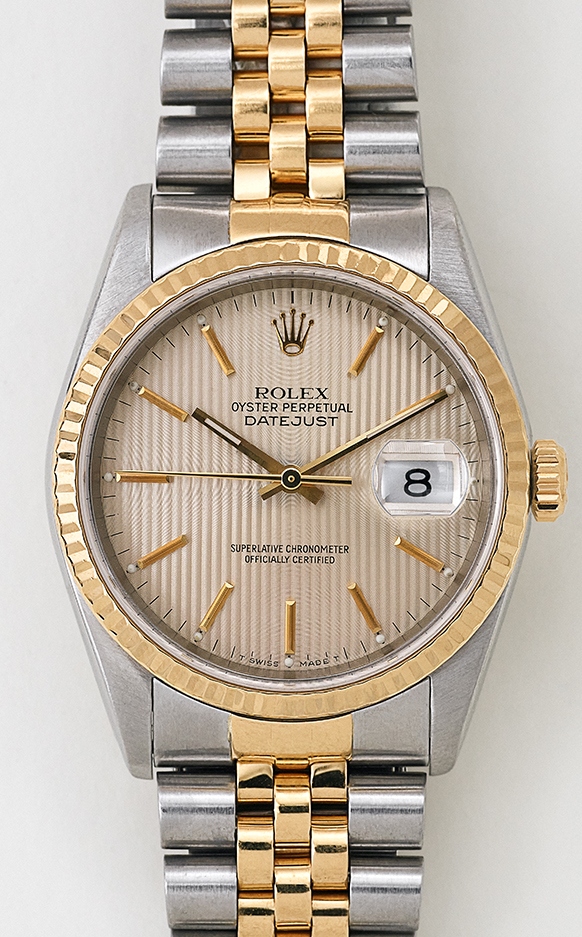
The hour and minute markers on a genuine Rolex Datejust should be evenly spaced.
When inspecting the dial, what key authenticity indicators are you looking for?
The dial on an authentic Rolex should fit flawlessly in the case. When looking through the crystal you should not be able to see any gaps where the dial and the case meet. The printing on the dial should be clear, sharp and precise. The crown logo and “Rolex” branding, as well as any other printing, should be centered. Hour and minute markers should be evenly spaced and aligned.
What do counterfeiters usually get wrong about the dial?
The level of precision you expect to see from Rolex can be difficult for a counterfeit to replicate. Check the size of the markers and how they’ve been applied. The markers on a counterfeit will frequently be a bit too large, sometimes too small, and epoxy is sometimes visible as well. The writing on a counterfeit will frequently have wavy edges, while the writing on a genuine dial should appear to be stamped with precision.
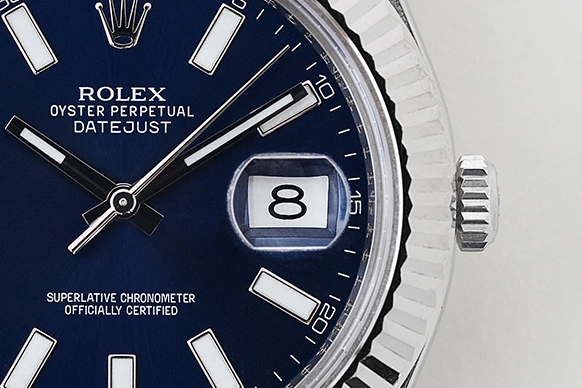
The date window on an authentic Rolex Datejust should have a magnification of 2.5x, and be centered over the three o’clock marker.
The date window is a key feature of the Datejust. What details should be present on the real deal?
The Cyclops lens over the date wheel should magnify the numbers 2.5 times, and it should always be centered over the three o’clock marker. This is an aspect that can be difficult for a counterfeiter to replicate. Always check to confirm that the numbers on the date wheel are being magnified by the Cyclops lens. Frequently, counterfeits cannot get the magnification size correct, or they will even skip it altogether and print the numbers on the date wheel in a larger size to mimic the magnification.
Real Rolex Datejust: The Functionality
What aspects of a Rolex Datejust’s functionality help you determine its authenticity?
With very few exceptions, Rolex watches are mechanical watches. A mechanical watch functions on the movement of gears slowly unwinding rather than a battery-operated quartz movement. A quick way to tell the difference is to observe the movement of the second hand. If you can visibly see the second hand jump from second to second, one tick per second, you are looking at a quartz watch — and if you notice this on a Rolex Datejust, something’s wrong. A mechanical movement should exhibit a sweeping second hand, which means the second hand should have the appearance of moving smoothly without jumping from second to second. You can also hold the watch to your ear to double check what kind of movement lies within. If you hear one tick per second, this is indicative of a quartz movement, and should be a red flag.
Real Rolex Datejust: The Craftsmanship & Materials
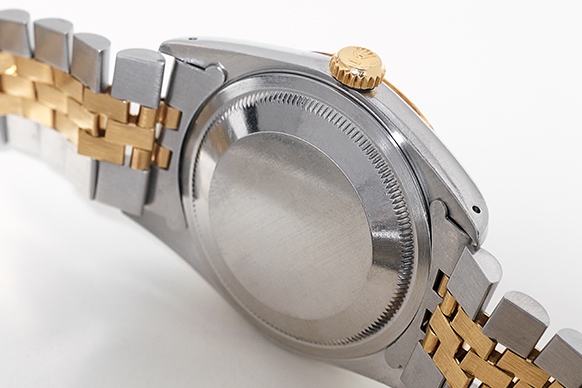
Most casebacks on authentic Rolex Datejusts should be smooth, and free of engravings.
Can you discuss Rolex’s craftsmanship standards, and the materials that authentic Rolex Datejust watches are commonly made of?
The attention to detail should be impeccable. Everything on an authentic Rolex Datejust is made to fit perfectly, using the highest quality materials. When you pick up a Rolex, it should feel substantial. The case and the bracelet should be made of solid metal, whether it is stainless steel, gold or a combination of the two. The watch should feel solid and relatively heavy. Most Rolex models will have a smooth, solid metal, non-engraved caseback, free of manufacturer’s engravings. A Rolex Datejust should not feature an exhibition caseback.
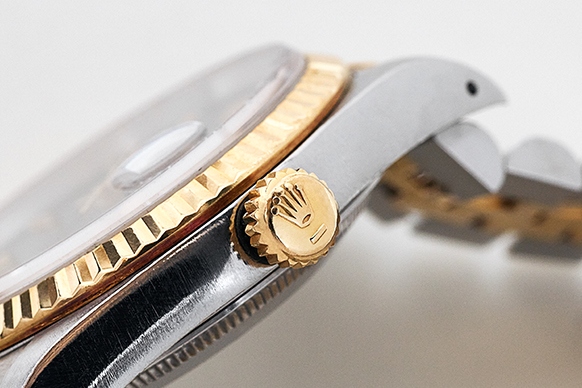
The crown logo on a Rolex Datejust’s crown should be easily visible and tactile.
The bezel on a Rolex Datejust is made to fit the case. It should not extend past the edges of the case, it should not fall short and it should lie flush. If the bezel is fluted, it is a gold bezel. The gold on a Rolex Datejust should always be solid gold, not gold-plated. The same goes for the winding crown as well; if it is gold, it should be solid gold. You shouldn’t see any base metal showing through beneath the yellow. The winding crown should be decorated with the crown logo, which should be easily visible and tactile.
If diamonds are used on the dial or bezel, they will always be the highest quality diamonds available, colorless and eye-clean with a color grading of D/E/F and clarity grading of IF (internally flawless). If the hour markers are diamonds, in most cases they will be single cuts.
Real Rolex Datejust: The Hallmarks
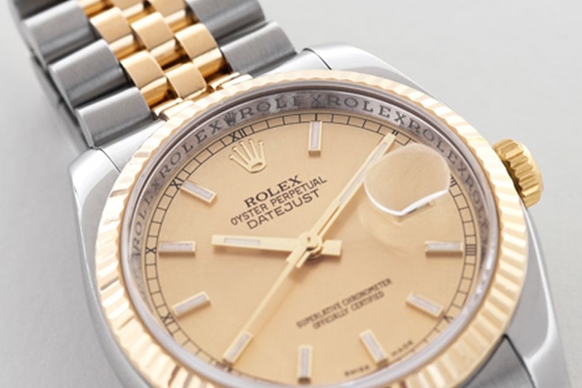
Rolex Datejusts produced in 2005 and later should include repeating Rolex text around the rehaut ring.
What serial numbers, hallmarks and logos should be present on an authentic Rolex Datejust?
Every Rolex watch has a unique serial number. Depending on the year the watch was manufactured, you should be able to find the serial number engraved at one of two locations: either between the lugs or inside the bezel under the crystal, at 6:00 in both instances. The model number should also be engraved between the lugs on the 12:00 side. The numbers should be engraved sharply and precisely, and should not appear to have been engraved by hand.
Models produced in 2005 and later should have a serial number visibly engraved on the rehaut ring (inside the bezel, under the crystal at the 6:00 marker). In addition to the serial number, “Rolex” should be repeatedly engraved around the rest of the rehaut ring. On the left side of the watch (from 6:00 through 12:00), all of the Rs in Rolex should line up precisely with the hour markers, and on the right side (12:00 through 6:00), all of the Xs in Rolex should line up precisely with the hour markers. The crown logo should also be present on the rehaut ring; it should be engraved at 12:00 and line up precisely with the hour marker and the crown logo on the dial.
The Rolex crown logo features five points and whenever it is present, it should always include an elliptical base — never round. The crown can most notably be found on the dial, on the watch’s actual crown and occasionally on the clasp closure. Models from the year 2003 and on should have a finely and precisely etched crown logo on the crystal, above the 6:00 marker.
All items are pre-owned and consigned to The RealReal. Trademarks are owned by their respective brand owners. No brand owner endorses or sponsors this ad or has any association and/or affiliation with The RealReal.
Please note: Brand standards, logos and other identifying features may have changed since the time of publication.


